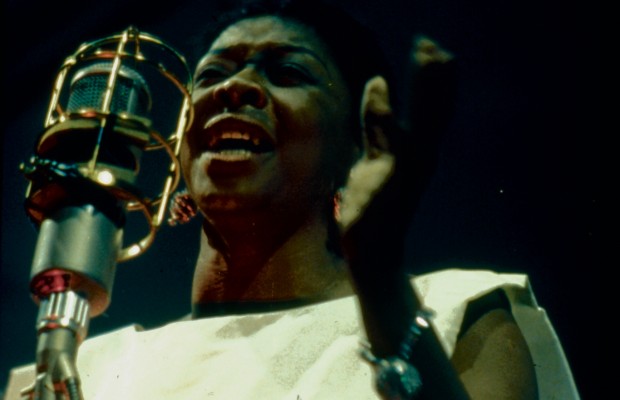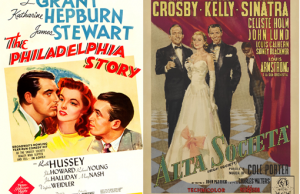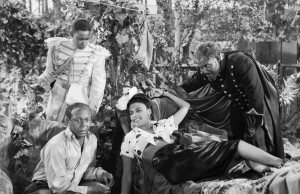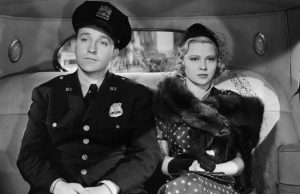Jazz on a Summer’s Day (1959)

Toronto Film Society presented Jazz on a Summer’s Day (1959) on Sunday, October 4, 2015 in a double bill with Paris Blues as part of the Season 68 Sunday Afternoon Film Buff Series, Programme 1.
Director, Producer, and Chief Camera Operator: Bert Stern. Production Company: Galaxy/Raven Films. Associate Producer: Harvey Kahn. Colour: Deluxe. Sound: Columbia Records. Recording Director: George Avakian. Production Manager: Allan Green. Script & Continuity: Arnold Pearl, Albert D’Anniable. Editor: Aram Avakian. Assistant Camera Ops: Ray Phealan, Courtney Hafela, Mike Cuesta, Jack Schatz, Pierre Streit. Cast: Louis Armstrong, Count Basie, Chuck Berry, Hoagy Carmichael, Duke Ellington, Chico Hamilton, Mahalia Jackson, Big Maybelle, Thelonious Monk, Gerry Mulligan, Anita O’Day, George Shearing, Jackie Teagarden, Dinah Washington.
FILM NOTES WRITTEN AND COMPILED BY RON ANGER, TFS, 1978:
Jazz on a Summer’s Day was suggested to the TFS Programme Committee in the year…[1960] by Dorothy Burritt, but was eventually turned down, partly because of its debatable quality as a movie and partly because the distributor, who was then handling it in Canada, wanted a laughably-high rental for a picture with little commercial possibilities. However, eighteen years can sometimes add a patina to a movie that it did not originally have. As it turns out, Jazz on a Summer’s Day stands as the only feature-length filmed documentary on a major jazz festival to have been made (it was shot and recorded during the Newport Jazz Festival from Thursday, July 4 to Sunday, July 7, 1958). Moreover, a depressingly large percentage of the musicians appearing in it have since died, and for a number of them it represents their only appearance on film. Thus, even if Jazz on a Summer’s Dayhad no merit filmically (and it does have merit), it would be important to see it now for the era, the event, and the persons it catches in its frames. Since it will add much to an appreciation of the movie now to understand that era, that event, the musicians, and the music they made, I will begin with those aspects, to be followed by quotes from the contemporary criticisms it received when released.
1958 was a year in which a man like Bert Stern, with no previous film-making experience, could be given a quarter-million-dollar budget, then an enormous sum for a non-fiction movie, to make a film about a jazz festival. During the 1930s and 1940s, jazz was appreciated and supported by a very small group of dedicated enthusiasts in white America, like George Avakian. Although black America’s musical taste had always been much more discerning, cultural and actual segregation had kept it from making much of an impression on the mass audience. However, as the 1950s dawned, and increasingly as that decade wore on, jazz began to be fashionable. It became the “in” thing for the young executive, professional, ad man, college student, and suburbanite to like jazz, and the jazz audience became quite a sizable mass audience in itself. As this trend manifested itself, it became apparent that a “jazz festival”, a series of concerts patterned after classical music festivals, could be a commercially viable undertaking. George Wein, a jazz pianist, entrepreneur, and club owner (most notably the Storyville Club in Boston) was able to persuade Louis and Elaine Lorillard, owners of the cigarette empire, to back a jazz festival in Newport, R.I. in 1954. It was a success and became an annual function of which Wein has remained the producer ever since.
Newport was one of the most long-established watering places of America’s super-rich, and they reacted to a jazz festival with utter horror. The principal failing of the festival was the programming of “big names” to draw ever-bigger crowds with insufficient attention to musical quality, and in 1958 this culminated in the booking of several rock ‘n’ roll stars. The Festival was held entirely out-of-doors, in Freebody Park, and the attendance in 1958 was over 60,000–twice the entire population of Newport twenty years earlier. Don Gold reported (Down Beat, August 7, 1958) that more beer…[had been] sold than at any jazz festival in history and that there were “corners of Freebody Park where music was of secondary interest.” …Dom Cerulli reported (op. cit.) that “For many of the patrons in the $3 seats at the back, the stage was virtually a rumour.” By 1959, the Festival had become a pawn in Elaine Lorillard’s divorce suit against her husband, and a few years later, the Festival was unceremoniously turfed out when what reporters had called “unruly” behaviour around Freebody Park in 1958 developed into actual riots. By programming non-jazz “names” to attract huge crowds, the Festival promoters also attracted punks who were there only to enjoy their idea of a “good time”. The Festival has, however, continued in another location to this day.
The 1958 Festival was extensively covered by the media: More than 700 reporters and critics; recording by four record companies; a one-hour broadcast each evening over the CBS national radio network; and, of course, the movie we are seeing…[this afternoon]. Apparently, Bert Stern and his crews (he shot everything with three cameras simultaneously) behaved so gauchely and created so much noise and disturbance during the musical performances that they made themselves royal pains. This culminated on the last day of the Festival, when the ever-gentlemanly Tony Scott had a heated exchange with the camera crews as to the noise they had made during his first performance. When they rudely ignored him and continued unabated during his next number, a quiet ballad, he simply stopped in the middle and announced that there would be no more music until filming stopped!
A great deal of the music played at the Festival is unheard in the film. All big band performances are omitted. Thus, we hear nothing from the International Youth Band, although its organization had been one of the triumphs of that year’s Festival; nothing from Duke Ellington or Benny Goodman, although both had complete evenings of the Festival devoted to them as tributes; and nothing from three other big bands which performed. The small groups of Miles Davis and Dave Brubeck are omitted; presumably, because they were sufficiently big names not to accept the scale of payment being offered by Stern. …No less than twenty more small groups or individuals are omitted; presumably, because their musical offerings went over Stern’s head and they did not display any of the visual idiosyncrasies that Stern’s superficial approach could seize upon.
…Bert Stern had a considerable reputation as a still photographer, doing advertising layouts for the big U.S. slick magazines, fashion work for the fashion magazines, and salon work for the most important photography publications and exhibitions; particularly, nudes. His work had a readily-identifiable, personal style. He had no prior movie-making experience and, [as]…far as I know, never tried his hand at the medium again. In his review in Films & Filming, John Cutts says of one’s appreciation of Jazz on a Summer’s Day: “…It makes no difference whether you like jazz or not.” Nothing could be further from the truth, as far as the critical reaction to the movie is concerned. It would, perhaps, be too unkind to say that jazz critics thought it must be great jazz, but there is considerable truth in that generalization. The reaction from the jazz side of the street is succinctly summed up by David Meeker in his book, “Jazz in the Movies”: “[The film is a] valuable record of the 1958 Newport Festival, though made in an irrelevant and obtrusive style.”
MORE REVIEWS ON THE JAZZ IN THE FILM:
Film Review by Robert A. Perlongo, Metronome, June, 1960:
“Bert Stern’s one hour and eighteen minute documentary of the 1958 Newport Jazz Festival cost a quarter of a million dollars to make and, for all that bread, one feels he ought to have put into his picture only the best of the music that was played there. He didn’t.”
Film Review by Herb Snitzer, Metronome, June, 1960:
“Photographically, Mr. Stern’s movie on the Newport Jazz Festival, and the cup races, and the dogs, and the babies, and the lights, is not a success. If he wanted to show the superficial thoughts most people have of a jazz festival, then I would say he was successful; however, I would think a man of Mr. Stern’s reputation would have tried to say something more. The movie could have been done in black and white, for the colour did not add anything to what Mr. Stern was saying, and I wasn’t always sure what he was trying to say. There was no development of a theme or idea, except the usual approach of a photographer interested in recording an event, rather than interpreting it. It seemed that every ten minutes of film were separate sections pieced together with the splicing machine, rather than with a creative mind searching for something more. There were a few exciting moments; however, the most beautiful being the lone figure of Nat Gershon, Chico Hamilton’s bass player, all alone and deeply involved with his music. This picture is a beginning, but only a beginning, for something greater should have been done, considering the creative freedom available to Mr. Stern. Unfortunately, it did not come off.”
Film Review by John W. Norris, Coda, September, 1960:
(Reviewing the screening of Jazz on a Summer’s Day at the Stratford Film Festival, August 26, 1960.)
“This is not a jazz film…. The film is very well made, with excellent photography and fairly successful editing. There is, perhaps, too much jumping from scene to scene, but this may have been an attempt to keep the story moving quickly. It will appeal to a wide audience, for there are many very humourous shots of extraordinary people doing extraordinary antics…. As a movie, it is first-rate, and its entertainment value is high. Where Jazz on a Summer’s Day fails, as far as I’m concerned, is in what should be its most important aspect. This is the music. Bert Stern proves, in the few shots he shows us, that he has the ability to make the movements and playing of the musicians stimulating and creative. Unfortunately, there is all too little about the musicians in Jazz on a Summer’s Day…. The main emphasis of [the film]…was the audience. Now, an audience is very boring to look at—most of it, anyway…[but] Newport also attracts delinquent college [students and] teenagers. It is this minority who are the focus of attention of Bert Stern’s camera; naturally, I suppose. They make effective and colourful ‘copy’. Shown in the picture the way they were shown gave a firm impression of anyone who doesn’t know…. What wonderful opportunity there was at Newport—but Bert Stern didn’t take it.”
ON THE MUSIC AND THE MUSICIANS:
The Train and the River—The Jimmy Giuffre Three: Bob Brookmeyer (valve trombone), Jimmy Giuffre (tenor, baritone saxophones, clarinet), Jim Hall (electric guitar):
This is the opening number in the picture. Giuffre was a modernist–one of the “Four Brothers” of late-bop tenor sax fame—who, by this time, had decided to dig back into the roots of jazz to its folk origins, playing a strange combination of primitivism and sophistication. “Giuffre’s set was a well-matched string of musical pearls.” (Dom Cerulli)
Blue Monk—Thelonious Monk (piano), Henry Grimes (bass), Roy Haynes (drums):
Thelonious Monk is one of the great individualists in all of jazz history. A kind of “grey eminence” of the bop movement, he was then just becoming known to a wider audience. Blue Monk, one of his finest compositions, is a blues performance of majestic simplicity going back in spirit to the earliest days of jazz, but with Monk’s characteristics nevertheless strongly in evidence. Stern’s insensitivity in coupling this performance with shots of the America Cup yacht race trials and staticky ship-to-shore weather reports is the single most-often-read criticism of the movie. “Thelonious Monk showing again his great debt to Jimmy Yancey.” (Robert A. Perlongo) “An excellent number.” (John W. Norris) “His playing of his own haunting theme.” (Alfred Appel, Jr.)
Concerto for Cootie (popularized as Do Nothing Till You Hear From Me) (composed by Duke Ellington)—Rex Stewart and the Ellington Alumni: Rex Stewart (cornet), Cootie Williams (trumpet), Tyree Glenn (trombone), Hilton Jefferson (also), Ben Webster (tenor), Billy Strayhorn (piano), Oscar Pettiford (bass), Sonny Greer (drums):
This is all that remains in the movie of a complete evening given over to a tribute to Duke Ellington. As the name indicates, the group is made up of famous former members of the Ellington band, extending all the way from Sonny Greer, who joined the “Duke’s” band in 1919, to Billy Strayhorn, who was still with the band in 1958.
Sweet Georgia Brown; Tea for Two—Anita O’Day, one of the all-time greats of jazz singing, in a gorgeous cartwheel hat, accompanied by Jimmy Jones (piano), Whitey Mitchell (bass), John Poole (drums):
Dom Cerulli reported that her set “swung hard”, particularly a “ripping” Tea for Two; “Anita O’Day doing amazing things to Sweet Georgia Brown and Tea for Two.” (Robert A. Perlongo) “Anita O’Day…belting into Tea for Two.” (Penelope Gilliatt) “Anita O’Day making mincemeat of Sweet Georgia Brown and Tea for Two.” (Bosley Crowther)
Sweet 16—composed and performed by Chuck Berry (vocal, electric guitar), an early rock ‘n’ roller whose work influenced The Beatles:
“Some wonderful facial expressions by Jack Teagarden and Jo Jones during Chuck Berry’s ‘show’. (How did he get into a jazz movie, anyway?)” (John W. Norris) “A tasteless rock ‘n’ roll effort.” (Monthly Film Bulletin)
Blue Sands—Chico Hamilton Quintet: Eric Dolphy (alto, flute), Fred Katz (cello), unknown (electric guitar), Nat Gershon (bass), Chico Hamilton (drums):
Hamilton’s modernist chamber group had unusual instrumentation, arrangements, and compositions, and achieved great success. This is one of the earliest appearances of Eric Dolphy, patron saint of the present avant-garde movement. “…Featuring some fine Hamilton drumming.” (Dom Cerulli) “Chico Hamilton, despite a defective bass pedal, performing with great artistry.” (Robert A. Perlongo) “Some extended excursions in Eurasia.” (John W. Norris) “Chico Hamilton, bending over his drums, his hands below the camera view, seems mesmerized by his solo—part rhythm, part ritual.” (Alfred Appel, Jr.)
Rockin’ Chair—Louis Armstrong and the All Stars:
Louis Armstrong (trumpet, vocal), Trummy Young (trombone), Peanuts Hucko (clarinet), Billy Kyle (piano), Mort Herbert (bass), Danny Bercelona (drums): [This was] augmented by special guests Bobby Hackett (cornet) and Jack Teagarden (trombone, vocal), who had played with the All Stars when the group was first organized in [the] 194[0s].
Lazy River; When the Saints Go Marching In; Tiger Rag—The regular All Stars personnel:
Often called the greatest single jazz musician of all time, Louis Armstrong had, by this time, acquired tremendous popular success, as well. “Louis’ horn was glorious. He had full command of the instrument and sent ringing bursts of melody clearly to every part of the huge park…Louis was superb.” (Dom Cerulli) “…The magic personality of Louis Armstrong.” (John W. Norris)
The Blues—Sal Salvador (electric guitar) and Sonny Stitt (tenor) accompanied by Gildo Mahones (piano), Martin Rivera (bass), Louis Hayes (drums):
“…Featuring Sonny’s charging tenor.” (Dom Cerulli) “Sonny Stitt’s searing, up-tempo solo.” (Alfred Appel, Jr.) “…Fine playing by Sonny Stitt.” (John W. Morrie)
Dixieland—Eli’s Chosen Six:
As the name implies, a group of enthusiastic students from that university.
All of Me—Dinah Washington (vocal, vibraphone), Don Elliott (mellophone), Urbie Green (trombone), Terry Gibbs (vibraphone), Wynton Kelly (piano), Paul West (bass), Max Roach (drums):
Elliott and Gibbs were noted for their vibraphone duets, but on this occasion it is singer Dinah Washington who duets with Gibbs. “Rousing.” (Dom Cerulli)
Rondo—George Shearing Quintet:
Originally from England, pianist Shearing’s sophisticated U.S. group was then one of the most popular in jazz. “…The never-ending riff of Rondo.” (Dom Cerulli) “Wafting ripples of…excitement into the night.” (Bosley Crowther)
Catch as Catch Can—Gerry Mulligan Quartet: Art Farmer (trumpet), Gerry Mulligan (baritone), Bill Crow (bass), Dave Bailey (drums):
Perhaps best known to movie people as Judy Holiday’s husband, Mulligan was a modernist whose pianoless quartette, playing his distinctive arrangements and compositions, had been both a trail-blazer and a great success.
Didn’t It Rain; Gonna Shout All Over God’s Heaven; The Lord’s Prayer—Mahalia Jackson (vocal) accompanied by Mildred Fall (piano):
From 12:30 to 1:20 a.m., she “sang a 12-song program with tremendous warmth and feeling…her every offering was greeted with huge audience response…the audience would have sat through the pouring rain most of the morning, if she had continued.” (Dom Cerulli) “…The moving power of Mahalia Jackson.” (John W. Norris) “She hushes the rowdy audience to silence, then begins to sing as if she were serenading the faraway stars….” (John Cutts)
I Ain’t Mad at You—Big Maybelle (vocal) accompanied by the Newport Blues Band: Lennie Johnson, Buck Clayton (trumpets), Jack Teagarden (trombone), Rudy Powell (alto, clarinet), Georgie Auld (tenor), Buddy Tate (tenor), Rudy Rutherford (baritone, clarinet), Pete Johnson (piano), Tommy Bryant (bass), Jo Jones (drums):
Georgie Auld hails from Toronto. “A breathtaking solo by Buck Clayton.” (John W. Norris)
Notes compiled by Hanna Miller













Leave a Reply